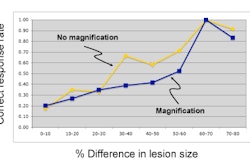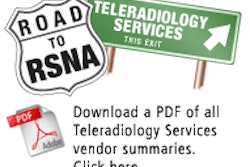While the Mayo Clinic in Scottsdale, AZ, for the most part has been satisfied with its PACS, the facility has experienced some technical limitations that have hampered workflow and image transmission.
To solve the IT issues and deliver patient images more efficiently to and from technologists and radiologists, Mayo is utilizing new technologies to balance the workload of incoming images and distribute the data in a timely way to the appropriate destination.
Mayo's PACS has a centralized database and centralized short-term storage server located on Mayo's hospital campus. In its original IT configuration, Mayo's modalities send images through one of eight DICOM acquisition servers to its PACS. The servers also send images to Mayo's short-term storage archive.
Mayo has a maximum of 10 modalities interfaced on each DICOM acquisition server, but only four of those modalities can send concurrently through a given DICOM acquisition server.
"There is no load balancing. If there is a fifth modality that is ready to send [images] to the PACS, it has to wait until a connection opens up," said Dr. William Eversman in Mayo's radiology department. "If any one of the DICOM servers fail, the cluster of modalities served by that server can't send images to the PACS."
Load balancing
In addition, if a DICOM server is occupied to its maximum, but other servers are free to handle image overflow, there is no way to tie into the underutilized servers in any real-time way. "So, there is no load balancing in our current system," added Eversman during his presentation at the 2008 Society for Imaging Informatics in Medicine (SIIM) meeting in Seattle.
When a server goes down, Mayo's clinical engineers have to reboot the server in hopes that it will come back online. "If it is a hard downtime and it is down for an hour or two, the clinical engineers have to go to the modalities and reconfigure them to send to a different server," Eversman explained. "When the server is finally fixed, they have to do everything in reverse -- go back and reconfigure them to send back to the [original] server. It can be a headache if one of those boxes goes down."
Mayo also discovered another shortcoming of its PACS regarding CT workflow. Often the facility sends CT datasets to as many as four destinations. Image transmission takes eight to 10 minutes to complete on most days, and with network traffic, that routing could take longer. While a technician scans the next patient on the CT, those transmissions are slowed. "So our techs are waiting to scan patients and radiologists get delayed because they are waiting for the studies to come to the PACS," Eversman said.
After exploring its options, Mayo turned to PACS technology provider Acuo Technologies of St. Paul, MN, and network hardware and applications developer Cisco Systems of San Jose, CA, to help reconfigure its IT system to eliminate the bottlenecks.
With the installation of Cisco's Content Services Switch and Acuo's Services Grid, Mayo has been able to route clinical images, including large-volume CT datasets, to the appropriate destination and help maintain productivity in the radiology department.
Redesigned configuration
Under the new design, Mayo's modalities are clustered as a single entity, with all images routed through a content services switch from Cisco, which balances the traffic volume between two Acuo servers. With the benefit of a shared distributed loop (SDL) database connecting the two servers, Acuo technology can send multiple copies to Mayo's PACS and 3D workstations. The servers also acknowledge the network's attached storage (NAS) device.
Image distribution is still preconfigured across the eight DICOM acquisition servers in the PACS, and each modality is directed by Acuo's servers to send to a specific primary DICOM acquisition server.
"What is new is if the first DICOM acquisition server is unavailable, is maximum occupied, or it fails, the Acuo software is able to route a second image to a secondary DICOM acquisition server," Eversman said. "This provides some redundancy and some load balancing."
Each server by itself is capable of 99 concurrent DICOM associations. It also is expandable with no downtime, he added, if Mayo were to add a third or fourth server in the future based on volume.
System testing
For CT images, technologists send one copy of a study to the new servers. Then, based on revised commands, the new servers know the kind of study received and how many destinations to which to route it. In this new configuration, CT technologists are free to scan the next patient without adversely affecting image transmission or waiting until the delivery of CT images is completed.
To verify its new design, Mayo tested the transmission of patient images by simulating disruptions in the service. "The first thing we did was try to disable the CSS or Cisco switch by simulating the loss of network activity," Eversman said. In response, data automatically flowed into the backup switch and onto the two servers to maintain workflow.
Mayo also disabled each of its new servers one at a time by simulating software failure or the loss of network connection. Again, image traffic flowed through the backup switch until the router could be brought back online. "During planned downtimes, we will use this to distribute images to the radiologists and route images to clinicians ... and not have them wait for images," he said.
With testing of the system substantially completed, Mayo has entered the final implementation stage of its new IT configuration. "We think it will help eliminate single points of failure with our current PACS, provide some load balancing with image traffic, enable more efficient workflow in CT, and provide a more reliable downtime plan for our department," Eversman said.
By Wayne Forrest
AuntMinnie.com staff writer
June 11, 2008
Related Reading
Software unifies control of multiple informatics applications, June 2, 2008
Communication and prevention are key to minimizing PACS downtime effects, May 19, 2008
Using informatics to meet communication challenges, February 7, 2008
High-tech communication tools improve patient care, studies find, December 6, 2007
Developing a cost-effective image QA workflow with PACS, November 21, 2007
Copyright © 2008 AuntMinnie.com



















